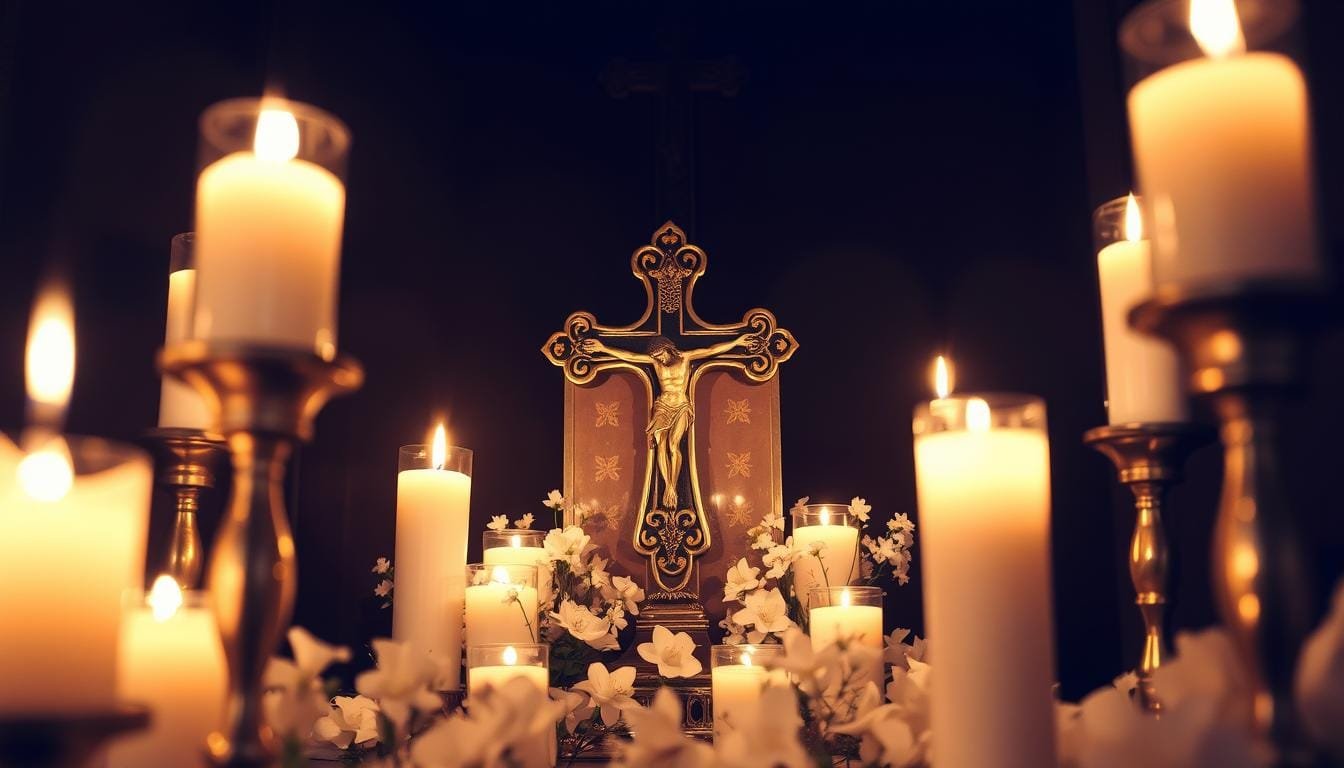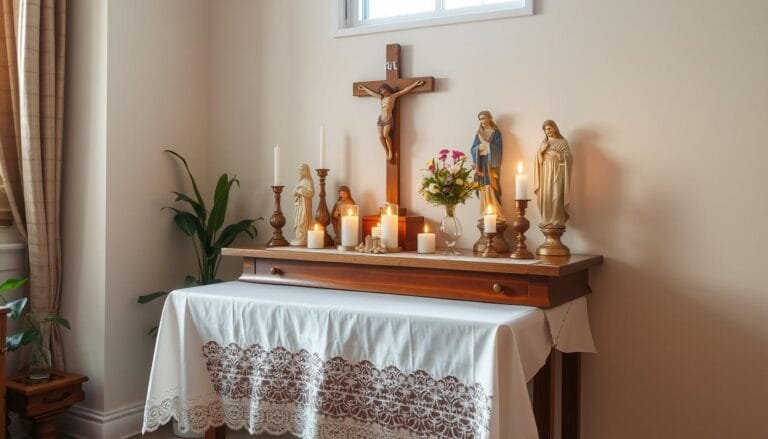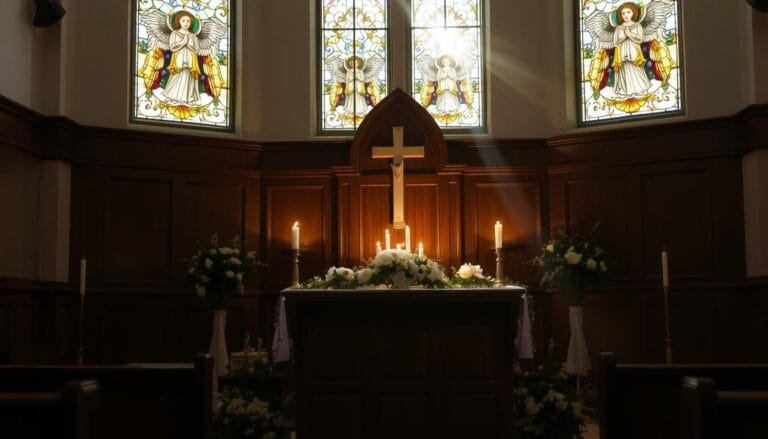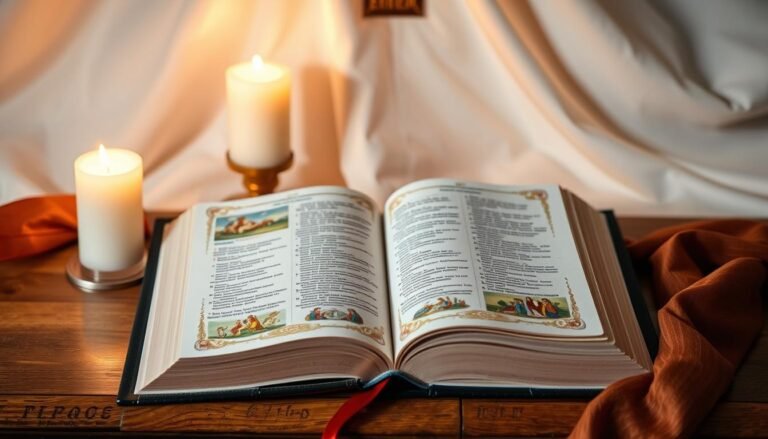Catholic Prayers for the Departed
This website contains affiliate links. As an Amazon Associate, I earn from qualifying purchases. The content on this website was created with the help of AI.
Catholics often wonder if their prayers reach those who have passed on. This question arises when dealing with the loss of loved ones.
Catholic prayers for the departed offer spiritual guidance and comfort.
These prayers honor loved ones and console grieving families. They help maintain spiritual connections with those who have died.
The Catholic tradition of praying for departed souls is deeply rooted. It’s based on biblical foundations and Church teachings.
These prayers provide solace and spiritual support to the bereaved.
Key Takeaways
- Catholic prayers for the departed offer comfort to both the living and deceased
- These prayers are rooted in biblical foundations and Church teachings
- Praying for departed souls is a way to honor loved ones and maintain spiritual connections
- The practice provides spiritual guidance for those grieving
- Catholic tradition offers various prayers and customs for remembering the departed
Understanding the Catholic Tradition of Praying for the Dead
Praying for the dead is a deep-rooted Catholic tradition. It’s based on our belief in purgatory and intercessory prayer. Let’s explore this meaningful custom’s foundations and growth.
Biblical Foundation for Prayers for the Deceased
Scripture supports our practice of praying for the dead. The Second Book of Maccabees mentions offering sacrifices for the dead’s sins. St. Paul’s letters also refer to prayers for the deceased.
“It is therefore a holy and wholesome thought to pray for the dead, that they may be loosed from sins.” – II Maccabees 12:46
Church’s Teaching on Purgatory and Prayer
The Catholic Church teaches that purgatory purifies souls on their way to heaven. Our prayers can help these souls prepare for eternal life.
This belief stems from the communion of saints and intercessory prayer’s power.
Historical Development of Memorial Prayers
Memorial prayers have evolved over centuries. Early Christian catacombs have inscriptions asking for prayers for the deceased.
This practice grew into formal liturgies for the faithful departed.
Today, offering Masses for the dead remains a key way to honor souls in purgatory. It shows our ongoing love and support for those who’ve passed on.
| Era | Development in Memorial Prayers |
|---|---|
| Early Christianity | Sepulchral inscriptions and acclamatory prayers |
| Middle Ages | Formal liturgies and requiem Masses |
| Modern Era | Specific prayers like Prayer of St. Gertrude |
These practices express our love for the departed. We trust in God’s mercy and the power of our prayers.
Catholic Prayers For The Departed: Essential Prayers and Their Meanings
Catholic prayers for the departed are crucial to our faith. They comfort both the deceased and their loved ones. Let’s explore some key prayers and their meanings.
The Requiem Aeternam is a fundamental prayer for the dead. It asks for eternal rest for the departed soul:
“Eternal rest grant unto them, O Lord, and let perpetual light shine upon them. May they rest in peace. Amen.”
Intercessory prayers are important in the Catholic tradition. We often ask saints to pray for the deceased. A common prayer calls on Saint Joseph:
- O Saint Joseph, foster father of Jesus, pray for us and the souls of the faithful departed.
- Guide them with your protective care to the eternal light of Christ.
- May they find peace and rest in God’s loving embrace.
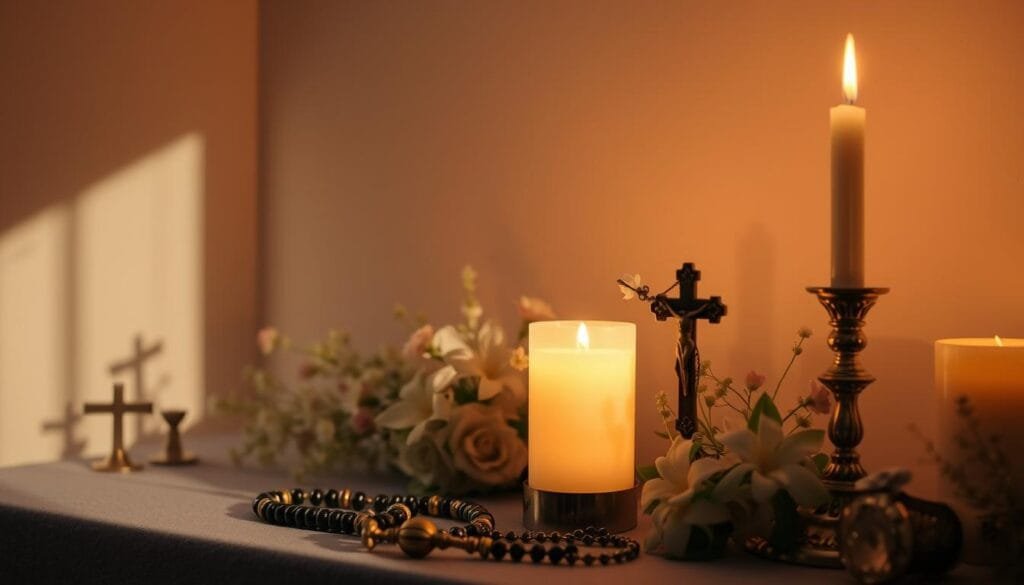
The Prayer of Commendation is often said during funerals. It entrusts the soul to God’s mercy:
“Into your hands, Father of mercies, we commend our brother/sister in the sure and certain hope that, together with all who have died in Christ, he/she will rise with him on the last day.”
| Prayer | Purpose | When Recited |
|---|---|---|
| Requiem Aeternam | Seek eternal rest | Throughout the year |
| Prayer of Commendation | Entrust soul to God | Funeral services |
| De Profundis | Plea for mercy | November (All Souls’ Month) |
These prayers show our belief in eternal life and intercession. They comfort mourners and help departed souls. They capture the heart of the Catholic faith and tradition.
The Role of All Souls’ Day in Catholic Memory
All Souls’ Day is a special Catholic tradition. It falls on November 2nd, right after All Saints Day. Catholics worldwide unite to pray for their departed loved ones on this day.
This day focuses on remembering and praying for souls who have passed away. It’s a time of reflection and honoring those no longer with us.
The Significance of November 2nd
November 2nd is a day of solemn reflection for Catholics. We gather to honor those who have died and pray for their souls. This date is rooted in the belief of purgatory.
Catholics believe in the power of prayer to aid souls on their heavenly journey. The day carries deep meaning for those who observe it.
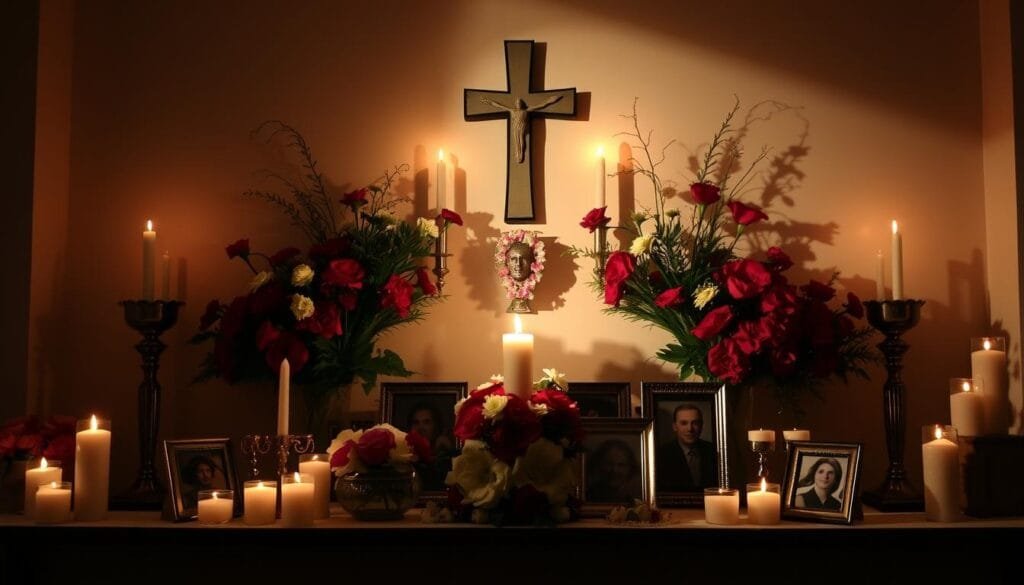
Special Liturgical Celebrations
Catholic churches host special Masses for the deceased on All Souls’ Day. These services include readings that comfort the grieving and remind us of eternal life.
Many parishes hold candlelight services too.
Each flame in these services represents a soul remembered in prayer. It’s a visual reminder of the connection between the living and the dead.
Customs and Traditions Around the World
All Souls’ Day traditions vary globally, reflecting diverse cultural influences. Some common practices have emerged across different Catholic communities.
- Visiting cemeteries to clean and decorate graves
- Lighting candles in memory of the departed
- Offering food or gifts at gravesites
- Engaging in acts of charity in honor of the deceased
| Country | All Souls’ Day Tradition |
|---|---|
| Mexico | Día de los Muertos celebrations with colorful altars |
| Philippines | Family gatherings at cemeteries for prayers and picnics |
| Poland | Lighting candles on graves and reciting prayers |
These customs show how remembrance is universal in the Catholic faith. They highlight the enduring connection between the living and the departed.
Each tradition reflects a unique way of honoring loved ones who have passed.
Praying the Rosary for the Dead
The Rosary is a powerful prayer for the deceased. Catholics find comfort in this practice when remembering departed loved ones.
It allows us to reflect on Christ’s life while seeking Mary’s help for the souls.
This meditative prayer connects the living and the dead. We focus on the Glorious Mysteries, highlighting the hope of resurrection and eternal life.
The Glorious Mysteries emphasize the hope of resurrection. This practice aligns with Catholic spirituality. It strengthens the connection between the living and the dead through prayer.
Here’s a simple guide to praying the Rosary for the dead:
- Begin with the Sign of the Cross
- Recite the Apostles’ Creed
- Pray the Our Father
- Recite three Hail Marys for Faith, Hope, and Charity
- Pray the Glory Be
- Announce the first Glorious Mystery and pray the Our Father
- Recite ten Hail Marys while meditating on the mystery
- Conclude with the Glory Be and the Fatima Prayer
- Repeat steps 6-8 for the remaining mysteries
- End with the Hail Holy Queen and the closing prayer
You can apply the intention of praying for the deceased to any set of mysteries. Offer your prayers with love and devotion. Trust in God’s mercy and the power of Our Lady’s intercession.
| Glorious Mysteries | Intention for the Deceased |
|---|---|
| The Resurrection | For the hope of eternal life |
| The Ascension | For the soul’s journey to heaven |
| The Descent of the Holy Spirit | For spiritual purification |
| The Assumption of Mary | For Mary’s intercession |
| The Coronation of Mary | For the soul’s glorification in heaven |
Memorial Masses and Remembrance Services
Catholic rituals offer comfort and closure for mourning families. Memorial Masses and remembrance services honor the departed and support the grieving.
These sacred traditions help maintain a spiritual connection with those who have passed on.
Requesting Memorial Masses
To arrange a memorial Mass, contact your local parish office. Many churches offer this service for a small donation. You can schedule Masses on significant dates like birthdays or anniversaries.
Some parishes have online systems for requesting memorial Masses. This makes it easier for families to honor their loved ones.
Participation in Funeral Liturgies
Funeral liturgies are powerful Catholic rituals that unite communities. We pray for the deceased and support their families during these services.
The prayers often include responses like “Lord, hear our prayer,” creating unity among attendees.
These liturgies emphasize hope, peace, and the continuity of faith. They provide comfort and strength to those mourning the loss of a loved one.
Ongoing Remembrance Practices
Catholics have various ways to remember the departed beyond funeral services. These include:
- Lighting candles at church
- Visiting gravesites
- Offering prayers on All Souls’ Day
- Creating prayer cards or memory books
These practices help keep the memory of our loved ones alive. They offer comfort and strengthen our faith.
By participating in remembrance services, we honor the deceased and build our Catholic community.
Supporting Grieving Families Through Prayer
Catholic communities harness prayer’s power for grief support. Our faith guides us to comfort mourners through spiritual connections. We offer solace to those in sorrow.
Communal Prayer Gatherings
Communal prayer is a key support for grieving families. We unite to share in their sorrow, fostering healing and hope. These gatherings strengthen our community bonds through shared faith expression.
Prayer Cards and Novenas
Prayer cards serve as tangible reminders of our ongoing support. Novenas, nine-day prayer cycles, add structure to our intentions. These practices help maintain focus during tough times.
Digital Prayer Communities
Digital prayer communities expand our support reach. Online platforms let us offer prayers across distances. This ensures no grieving family feels alone in their loss journey.
| Prayer Support Method | Benefits |
|---|---|
| Communal Prayer | Shared strength, immediate support |
| Novenas | Structured prayer, sustained focus |
| Digital Communities | Wide reach, continuous accessibility |
Grief is a unique journey for everyone. We offer various prayer support options to meet different family needs. Our dedication to prayer shows our belief in its healing power.
Conclusion
The Catholic tradition of praying for the dead offers spiritual comfort and honors our departed loved ones.
The 9-day prayer for the dead shows the depth of this practice. It connects us to the Church Militant, Suffering, and Triumphant.
Catholic beliefs in purgatory and the Communion of Saints highlight these prayers’ importance. We pray to help souls on their journey to heaven.
This act of remembrance bridges the gap between the living and the dead.
These prayers comfort grieving families on All Souls’ Day and throughout the year. They remind us of God’s endless mercy and our role in spiritual works.
By praying, we keep the memory of our loved ones alive.
This practice fosters hope in the resurrection promised by our faith. It strengthens our connection to those who have gone before us.
Through prayer, we continue to support and love them beyond this life.
